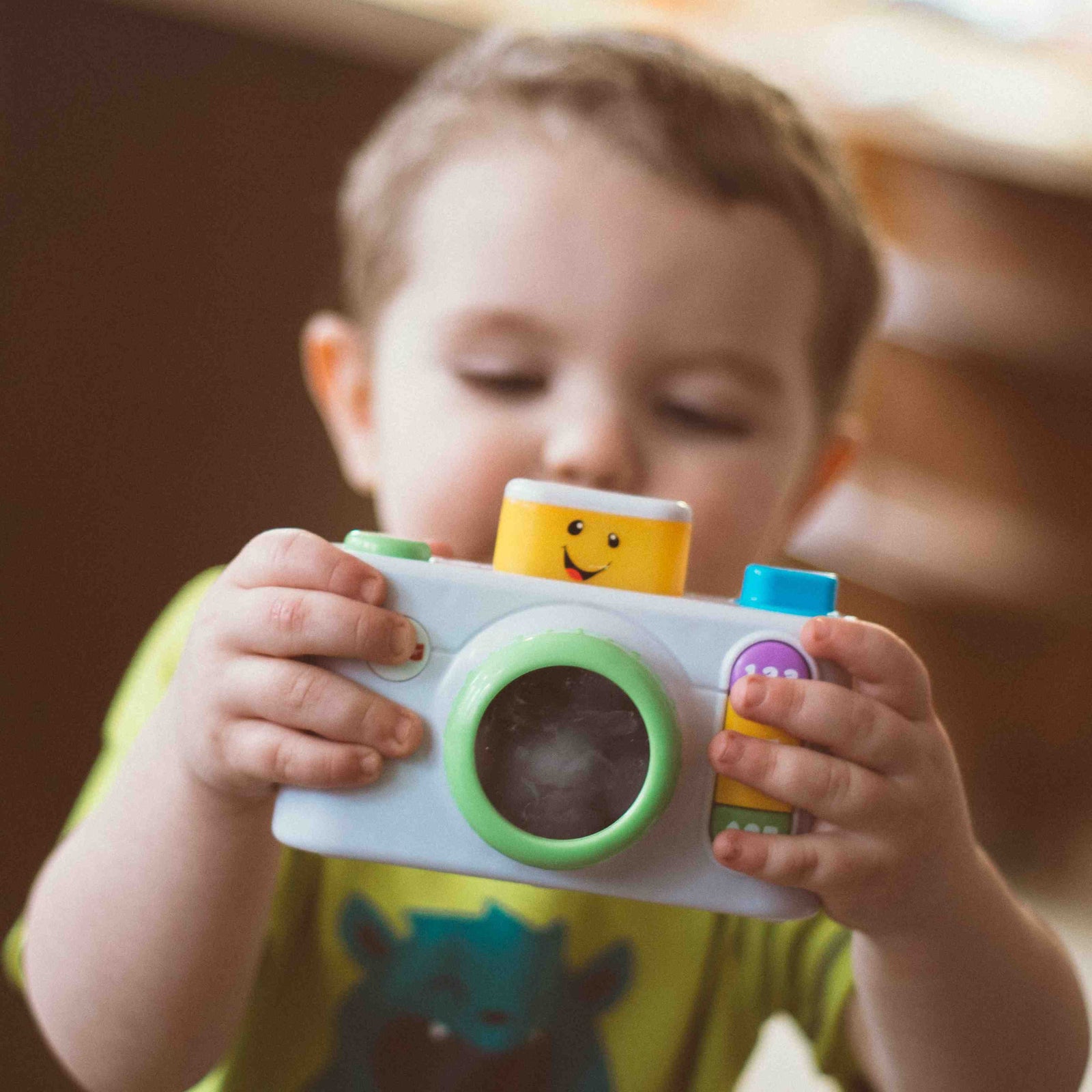Your Cart is Empty
~ Waiting List in Operation ~ Please Ask Before Ordering ~
~ Personalised jewellery to treasure forever ~
~ Waiting List in Operation ~ Please Ask Before Ordering ~
~ Personalised jewellery to treasure forever ~

Photography for Children - 65 promts for child photographers
February 13, 2021 8 min read
One of the best presents my children ever got for Christmas was one of those Vtech Kidizoom cameras. You know the ones. Big, chunky and impossible to break (even when dropped in the bath tub) – fabulous!
That was 10 years ago, when the idea of children having their own tablets and phones wasn’t really *a thing*, but you know what? That clunky blue camera and the (pretty dreadful) photographs it took, sparked something.
It sparked interest in capturing images of their world. Snippets of their everyday lives. Fun times, special occasions and all those the mundane moments in between (the pot plants, the photos of their lunch and the cat…….. you get the idea).
Just like the 1 billion people currently on Instagram, my children caught the photography bug and discovered just how much they LOVED to take photographs.
10 years on from that Christmas, that seemingly indestructible blue camera is now in the hands of child number 5 who like the others, is busy discovering the joy of photographing random objects inside the house, his own feet on the school run and the moments that capture his humungous imagination.
For his older brothers and sisters, tablets and phones for children have now indeed become *a thing* and I’m continually amazed at how much time they can spend snapping away, shooting photographs that now take pride of place on their bedroom walls.
So why should you encourage children to take more photographs and how can they get started?
- Your child does not need an expensive DSLR to get started with photography. My children got years of enjoyment snapping barely-recognisable pixelated images on that chunky toy camera, simply because they took the images themselves.
That’s the thing! As adults, we get into the habit of taking eleventy billion photographs, then sifting through them to find the *perfect shots*, but children really don’t look at the images they take in the same way. They don’t have the same ideas about what’s perfect and what needs to be discarded.
Toy camera, compact camera, tablet or for older children, a phone. If they can use it to take photographs and they’re not going to have you hovering over them worried that they might break it – it’s good enough. The quality of the photographs isn’t the aim here.
- Following on from the idea of capturing the perfect shot:
While it’s a great idea to provide gentle guidance to help your child improve their photography, don’t ever be tempted to tell your child that their photographs aren’t good enough and don’t go overboard with the *constructive criticism*.
These things will both have the same effect - To make your child overthink what they’re snapping at; to introduce doubt and to suck the creativity and joy out of what they’re doing.
- While being overbearing is to be avoided, some gentle guidance can be important.
Just like everyone, children can hit a creative brick wall and can end up feeling frustrated and stuck.
I really do try to keep my input as small as possible because I’m aware that they don’t find the same things interesting and we have very different ideas about what makes a great shot. I would never want to stifle their imaginations. Children do have a uniquely special way of looking at the world with fresh eyes, but it sometimes doesn’t hurt to give them a theme or direction.
Something I find really helpful, is to have a simple list of photography prompts to hand. It’s really just a cobbled together list of the things around them in their environment, but it’s amazing how useful a list of usually-overlooked things can be.
I’ve attached my list of 65 simple photography prompts for children below or you can download it here to print.
- Nothing is boring! You definitely don’t have to wait for a beautiful sunny day or a fun day out to dig out a camera. In fact, taking photographs can be a fun way to while away a few hours on a rainy day.
The *boring things* that your children used to seeing around them day in, day out, probably aren’t really boring at all, especially when photographed from their point of view.
Simple things like mirrors, windows, sunshine, shadows and water can create amazing shots.
- Thankfully, photography is one of those wonderful activities that seems to keep children of all ages engaged for hours at a time with very minimal input from you, although they will obviously get a lot more from it, if someone joins in with them.
They will of course love your feedback (they will in fact insist on showing you everything they take).
Going through their photographs with them for a little while and really taking an interest in pictures of their world from their point of view is time well spent and is a great confidence boost.
- Photography encourages them to step away from their screens and get outside!
Yes, I know that a lot of children end up taking photographs using their phones and tablets, but you know what I mean. Using a phone or tablet to take photographs for a few hours is very different from using a phone or tablet to play on Roblox or Minecraft.
At a time when most children now spend over 2 hours a day online, cultivating a hobby that encourages imagination, connection with the people around them, interest in the real world and doesn’t include Netflix, can’t be a bad thing. - Photography encourages them to explore. To surround themselves with nature and to learn about it. To really investigate the world around them up close. To look at the tiny details in their own environments that they might otherwise overlook. To be curious.
It’s really easy to take the things around us for granted.
We all do it! After all, we see our homes, gardens and possessions all the time. We tend to eat the same foods, often take the same journeys to work and school - Which is why cameras often only make an appearance on special occasions (or when we need to make an emergency photobook for Grandma’s birthday).
While children are much more likely to take notice of flowers and birds and insects, we don’t teach them about these things anymore.
My parents and grandparents could identify every tree, berry and bird call. Many children these days would be hard -pressed to tell a parrot from a pigeon.
Photography seems to foster a connection with nature that a lot of have lost.
- Photography is all about collecting memories and not things. We often only take photographs of the moments that matter the most to us. The things that prompt us to pick up a camera in the first place. The things we want to be reminded of.
Our photographs jog our memories so that we can look back and smile. So we don’t forget.
Children are no different.
But just like adults, children can collect an awful lot of photo memories in a very short space of time and they do tend to be left, forgotten on one sim card or another. Often deleted to make space.
Printing out their very favourite photos and popping them into a scrapbook is a great next step after taking the actual photographs.
Journalling their memories is a lovely habit to get into, encouraging them to think and feel and write. After all, their photographs do tell stories that deserve to be told and they are little works of art that deserve to be displayed and not deleted.
- Photography is an immensely rewarding hobby. One of the best things about it for us, is that there’s no right or wrong, so it’s great for encouraging creative thinking and self-confidence.
There’s a learning curve if they want to go down that route, especially as they get older - Learning how to deal with light, different camera settings and how to properly compose images - But none of that is compulsory.
You will probably soon find that they want to bring their camera around with them everywhere, just in case they stumble across something interesting – like we all do.
Out of all the activities my children have decided to start, photography is by far the easiest because apart from the actual camera, or phone, or tablet, they really don’t need anything else.
They’re not professional photographers, so they don’t need photography lights, or backdrops or Photoshop subscriptions, so the outlay is fairly minimal.
Once they get older, they will probably want to play around with editing apps, but these are a fun nice-to-have and definitely not a necessity.
- Photography can be really sociable. My children are perfectly happy to snap away on their own, but it is a lot more fun when they’re together with either their siblings or their friends.
As they’ve grown older, the more photographs they’ve take with their friends and (with parental supervision) their photographs have become a way for them to keep in touch with their friends, particularly when they’ve been apart (the 2020/2021 lockdown has a lot to answer for).
As a family, their photography habit has given us an extra reason to get outside together a little more. Extra walks and extra trips to the park. The same walks we’ve walked for years, with a little extra exploration. A bit more adventure. All of which is great for promoting positive mental health and general wellbeing.
65 Photography Prompts for Kids:
- Family – portraits and the day-today (reading, doing homework, housework).
- Hands and feet
- Hugs and kisses
- Sleeping
- Super close up macro shots – eyes, noses, faces, features.
- Heights and show sizes.
- First day of School in September. First day of the New Year.
- Special belongings, keepsakes and souvenirs.
- Hairstyles and favourite clothes
- Pets
- Self-portraits
- Blowing petals, leaves, glitter
- Day-to-day activities around the house.
- Gardening – Garden tools and muddy hands!
- Fun at home and playing,
- Other hobbies – drawing, playing an instrument.
- Arts and Crafts – paint, chalk, clay, playdough, (dare I say it) glitter and messy hands!
- Make believe and dressing up – Best smart clothes or costumes.
- Cooking and baking
- Tea parties
- Tents and teepee’s
- Stop motion – ok, so not strictly photography, but it is a lot of fun. It can be done inside and out, and it will keep them entertained for hours.
- Rain (rain on windows, rain falling, puddles, splashing, taps, reflections, umbrellas, icicles)
- Trees, bark, tree trunks, birds nests, insect homes.
- Flowers, leaves and petals. Flower structure.
- Throwing fallen piles of autumn leaves or cherry blossom petals.
- Birds, Animals, Insects
- Animal and insect homes at different times of the year – spider webs, birds nests.
- Nature finds – feathers, conkers, egg shells, snail shells, dandelion clocks.
- Sunshine – Sunrise, sunset, light rays, patterns.
- Shadows
- Light and Dark spaces
- Artificial lights – ceiling lights, fairy lights, lamps, shadows, Christmas lights.
- Candles (with adult supervision)
- Fruit, vegetables (indoors or from the garden). Whole, sliced or in segments.
- Teddy bears, favourite toys, bath toys, garden toys.
- Favourite Foods - Cakes and cookies on a plate. Summer salads. Birthday party meals.
- Drinks – cups of coffee, glasses of juice, ice, different containers, bubbles.
- Books
- Pens and pencils
- Schoolwork
- Bubbles
- Balloons
- Bunches of flowers and flower crowns.
- Windows
- Mirrors
- Reflections
- Pot Plants
- Colours
- Numbers and Letters.
- Collections (groups of similar things).
- Town centres, villages, houses, buildings.
- Bridges, landmarks
- Signs (shop signs, place signs).
- Vehicles – cars, buses, lorries, tractors, diggers, trains, aeroplanes.
- Seasonal activities – Pancake day, Chinese New Year, bluebell woods, Easter egg hunts, strawberry picking, summer picnics, paddling in streams or the sea, trips to the seaside, corn fields, hay bales (with permission), lavender fields, conker hunts, Halloween, fireworks, visits to Santa, Christmas shopping, Christmas light switch on.
- Seasonal crafts and decorations.
- Seasonal clothes – summer hats and sunglasses. Wrapped up warm – hats and scarves.
- A trip to the park – climbing frames, climbing trees, swinging.
- Flying a kite
- Sports activities – football, basketball, races, dancing, cheerleading.
- Scavenger hunt – choose a theme.
- School trips, plays, concerts and awards.
- Very special outings or occasions.
-
Photograph happy! Or what you think happy looks like.
Leave a comment
Comments will be approved before showing up.
Subscribe
Sign up to get the latest on sales, new releases and more …

Join the Club
WE'RE SO PLEASED TO SEE YOU!
Stay a while and look around.
While you're here, why not subscribe to our newsletter?We'll give you £20 off your first order, VIP access to new products, and access to our very special sample sales.We promise not to annoy you (honest).
